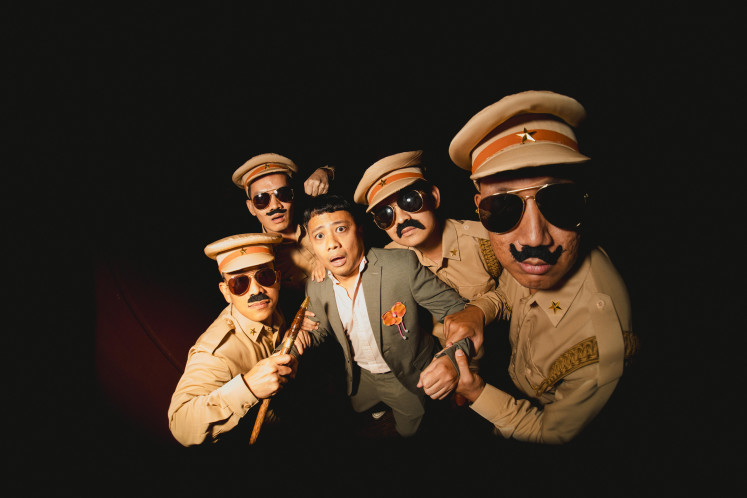Popular Reads
Top Results
Can't find what you're looking for?
View all search resultsPopular Reads
Top Results
Can't find what you're looking for?
View all search resultsJim Morris: His relationship with Pixar
Courtesy of superherohype
Change text size
Gift Premium Articles
to Anyone
Courtesy of superherohype.com
The stories in the films that stir emotions while moving animation technology forward are what make award-winning film and visual effects producer Jim Morris proud of being with Pixar Animation Studios.
'Working at Pixar is pretty close to a dream job. I've worked in different parts of the movie business, and it's really great to work at a company that is committed to making great films. I feel really lucky to be able to work there,' Morris told The Jakarta Post in a recent interview.
Morris, Pixar's president, spent a few days in Singapore for a presentation of The Good Dinosaur, which opens in Indonesia on Friday, and some of the studio's other upcoming projects.
Morris said that one of the most interesting and challenging parts of working at the studio came during the development of the stories and getting them to match with the animation.
'It's very complicated with a lot of different moving pieces needing to be aligned together to get the stories to work. But when you see them move forward, and then the film finally comes out, entertaining the audiences and touching their hearts and making them laugh, that's pretty gratifying,' he said.
Morris began his career in the film business with local television studios after he earned his postgraduate degree from Newhouse School at Syracuse University in New York.
In 1987, he joined Industrial Light & Magic (ILM), working on the visual effects of, among other projects, Steven Spielberg's Always and James Cameron's The Abyss, the later earning an Oscar for best visual effects.
He was then promoted to president of Lucas Digital where he oversaw ILM and Skywalker Sound for 11 years.
In 2005, he joined Pixar, which was then purchased by Disney in 2006. With Pixar, he has produced several critically acclaimed films, including Ratatouille, Wall-E, and John Carter. In 2014, he was appointed as the president of Pixar.
Morris' first interest in film was sparked when he watched the television program Disneyland when he was little.
'Walt Disney had a TV show. He hosted it himself and he would show his creations in the program. I couldn't wait to see it every Sunday night,' he said.
His interest in the film industry, especially animations, grew stronger after he watched the original One Hundred and One Dalmatians in 1961.
'There were many early films that I remember seeing, but when One Hundred and One Dalmatians came out, that sparked my interest further in Disney,' he said.
'When I was little, I didn't get the chance to go to Disneyland and Disneyworld as I lived far away on the East Coast. Now, I end up going there often just for meetings,' he said, laughing.
During the presentation, Morris also showed clips of Pixar's sequel projects ' Finding Dory and Toy Story 4 ' and one of its brand new projects, Coco.
'It's difficult to make sequels. On the one hand you don't have to invent the whole world, and you don't have to invent all the characters and they're very difficult parts of making an original,' he said.
'But once you've told a story in a certain world, the demands of telling a different story in that world with those characters we found to be very difficult.'
Jim Morris - Courtesy of pixar.wikia.com
Morris said that Finding Dory would hit theaters in June 2016, 13 years after the release of its prequel, Finding Nemo.
Dory will still be voiced by Ellen DeGeneres while Nemo's voice will be performed by Hayden Rolence, with many new characters also in the line-up.
Morris said that he and other Pixar crew members had agreed that they would not produce another sequel to Toy Story, after such a fantastic trilogy, unless, however, one of them could come up with a story that was too hard to resist making.
As it turns out, Pixar will in fact come back again with Toy Story 4, trying to keep the story fresh by teaming up with Rashida Jones and Will McCormack for the screenplay, while John Lasseter keeps his seat as the director.
Apart from talking about Pixar's latest projects, Morris also shared his opinion about the animation industry in Asia.
'The animation industry is growing up more. It has started to get its own voice and more films are made here, and I'm very much looking forward to seeing those and seeing the voices because I've always been a huge fan of Asian animations,' he said.
Morris also gave his two cents on the role of an animator in creating a high quality animation.
'The most single important thing [for an animator] is to develop a keen eye for how people act and behave, observing how people are and what people do,' he said.
'So when they're making the character come to life, they have things that they can use to act that out and bring that characters to life.'












